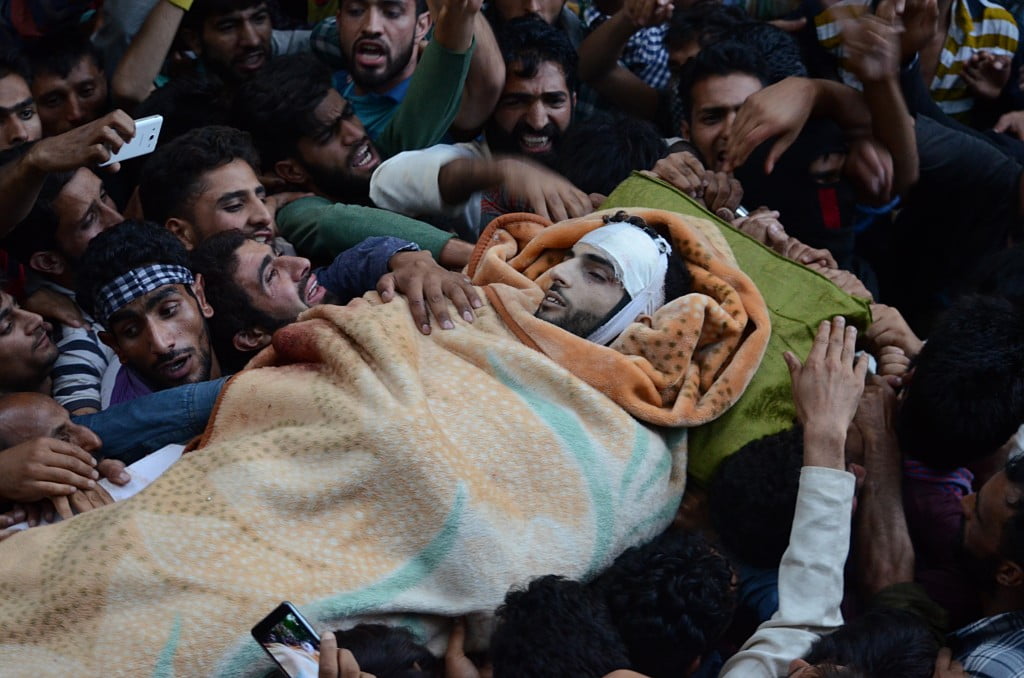
If the Centre wants permanent peace in Kashmir, it needs to revamp its policies and review its attitude towards the Valley, writes RIYAZ WANI
In the six years that he was alive, Hizbul Mujahideen commander Burhan Muzaffar Wani, 22, had acquired a cult-like status in Kashmir. The pictures and videos on Facebook of a tall handsome youngster with a Kalashnikov slung over his shoulder caught the imagination of a new Kashmiri generation deeply estranged from New Delhi. He presented a romanticized image of the militancy evacuated from the fraught nature of the option as a path that inevitably ends in death.
This had an immediate impact on the ground situation. Militancy which was in steady decline for over a decade, slumping to its lowest in 2012 suddenly began to re-organize. Burhan alone is said to have drawn more than 100 fresh recruits to Hizbul ranks, giving thus a fresh lease of life to the outfit which by 2011 had almost been wiped out, reduced to a little over two dozen active militants. The outfit was left further reeling by the killing of one of its senior-most commander Mushtaq Janghi in the same year. A few days ahead of this operation, security forces had arrested Mohammad Shafi, alias Dr. Dawood believed to be the then operational commander of the outfit.
But Burhan changed this. And he did this chiefly by taking to social media and turning militancy into a glamorous occupation. He would have none of the anonymity and the masked visages his predecessors and his foreign counterparts in Lashkar and Jaish preferred. His images and videos went viral on Facebook and later on Whatsapp, generating long comment threads and contentious debates and discussions. It also generated a fawning admiration from the disaffected youngsters to whom he seemed to offer an instant salvation and a sense of political agency.

The death of Hizbul Mujahideen commander Burhan Muzaffar Wani has renewed violence in Kashmir
“How handsome is the face of our brother,” read a post last year on the Facebook page — Trial: The Land of Martyrs. And under it was the bleary-eyed picture of Burhan Wani, with his hands languidly clasped behind his head. In the first few hours of being uploaded the post drew 900 likes and more than 60 comments, all of them exhibiting awe and respect for Burhan.
He had joined militancy in the rush of the extended 2010 revolt as a 15-year-old boy angry over the beating of his elder brother Khalid Wani by the security personnel when the two were running a family errand. The story has since become part of the legend about Burhan. Khalid was killed by forces last year when he was allegedly returning after meeting his militant brother in a forest.
“He was furious when he returned home. He wondered why his brother was beaten up when he had done nothing wrong,” recalls his grandfather Haji Ghulam Mohammad Wani, a grey-bearded former state government employee, who is proud of his grandson’s decision to take up arms. “He had always been a nice boy, who prayed five times, and an obedient son. Now that he had become a militant for the right cause, we stood by him.”
Burhan’s impact was on many fronts: he resuscitated a dying jihad and brought it to a critical mass where it started to bite again. He put Hizbul back in the vanguard of militancy by altering the ratio between local and foreign militants in favour of the former. By 2015, for the first time in a decade, 88 of the total 142 active militants were from Kashmir, two-thirds of them from Burhan’s South Kashmir. The equation still holds. By the latest count, around 145 militants are active in the Valley out of which 91 are locals and 54 foreigners. And this has already started reflecting in the fast changing security situation on the ground. In the past six months, 80 militants, over 30 security personnel and five civilians died in militancy related incidents. This shows a conspicuous rise in militancy as against 2015 during which 113 militants, 41 security personnel, and 20 civilians lost their lives in the militant violence.
However, not all of this violence can be attributed to Burhan who according to police had not “even fired a single shot”. The two high-profile attacks, one at Entrepreneurial Development Institute along Anantnag-Srinagar highway and another at Pampore which between them led to a loss of 11 security personnel were carried out by the Lashkar.
Burhan’s significance was more as a symbol. He had come to lend moral glamour to jihad at a time when the world sees it as a terrorist activity and heaps opprobrium on the pursuit of any violence in the name of a political cause. Adding to his charisma was the prevailing politics in the state which is generally seen as corrupt and responsive more to the demands of New Delhi than the aspirations of the people.
The widespread public revolt that followed the commander’s death and its spontaneity was beyond anybody’s imagination, even that of the people who participated in it. Moments after his death was announced, a flood of people poured out onto the streets, shouting pro-Azadi slogans and throwing stones.
The government response was harsh apart from the indiscriminate killings, which rose steeply within the first three days with over 30 falling to police and CRPF bullets and more than 1,500 hurt with scores sustaining pellet injuries in their eyes. Within two days of Burhan’s death, doctors at Srinagar’s SMHS hospital had performed 92 eye surgeries, including a 12-year-old girl, with prognosis for complete recovery of eyesight in many cases very bleak. The massive outbreak of violence has once again confronted New Delhi with its moment of truth in Kashmir. Pakistan Prime Minister Nawaz Sharif issued a statement expressing “deep shock at the killing of Kashmiri leader Burhan Muzaffar Wani,” and Hizbul Mujahideen supremo Syed Salahuddin and Lashkar founder Hafiz Saeed held a small prayer meeting in his memory. The United States expressed concern and so did the United Nations Secretary General Ban Ki-Moon.
But the large-scale outpouring of grief and anger in the Valley over the militant commander’s death underscores yet again that New Delhi has chiefly itself to blame for the state of affairs. Over the past two years, the new government at the Centre has dealt with Kashmir more or less in economic terms, abandoning all previous political initiatives and refusing to start new ones including those envisaged in the Agenda of Alliance which became the basis for its coalition with PDP. Prime Minister Narendra Modi offered 80,000 crore economic package but stopped short of a political engagement necessary to create a public perception of some sort of a resolution in progress. The fresh mass unrest should, therefore, be a wake-up call. New Delhi can only ignore it to its detriment.
Meanwhile, Hizbul has already announced its new commander for Kashmir identified as Mahmood Gaznavi, an alias which has some troubling political connotations. A serious and credible political effort to reach out to Kashmir is therefore urgently needed before another commander unleashes his social media charm offensive on Kashmir.
[Source:- Tehelka]



